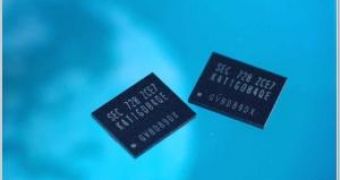Samsung Electonics announced that it has developed a new technology to produce the industry's fist 50nm based memory chips. The current standard for DDR2 memory chips is the 60nm process and Samsung estimates a 55 percent production efficiency increase once that whole memory sector adopts the new standard.
The new 1GB DDR2 memory chips feature advanced technologies such as three-dimensional transistor design and multi-layered dielectric technology, which greatly enhance performance and data storage capabilities. "With the 50nm DRAM development, we're continuing our technology leadership, paving the way for our customers to reap not only greater cost efficiencies but also to make superior products," said Nam Yong Cho, executive vice president of memory sales and marketing at Samsung Electronics' Semiconductor business, as cited by the site LetsGoDigital. The 3D transistors are equipped with broader electron channels that increase speed and minimize power consumption, while the multi-layered dielectric layer is used to resolve weak electrical features and at the same time it sustains higher volumes of electron to increase storage capacity, ensuring higher reliability in storing data.
The proprietary RCAT( Recess Channel Array Transistor) technology has also been adapted to work with the 50nm production process, more so since the RCAT which doubles the refresh term of DDR memory modules, is a critical technology in scaling DRAM capacities regardless of chip size. The new 50nm technology can be applied to a wide range of DDR memory chips, including video memory and mobile DRAM.
Almost at the same time, Intel announced that Samsung's 50nm DRAM technology in 1GB density has been certified to work with the company's existing and upcoming chipsets at speeds of 800Mbps. The mass production of DDR2 memory modules based on the 50nm design will begin in the first half of 2008, as well as the next generation memories like DDR3, GDDR4 and GDDR5, plus the latest mobile DRAM. When Samsung developed the 50nm prototype memory module in October 2006 and until now no other memory producer has come up with a similar production process, so most still use the 60, 80 or even the 90 nm technologies.

 14 DAY TRIAL //
14 DAY TRIAL //